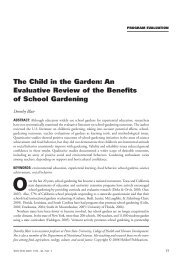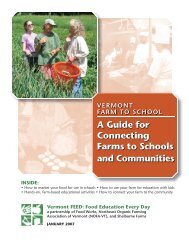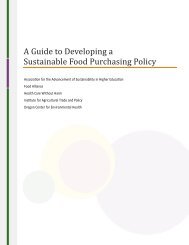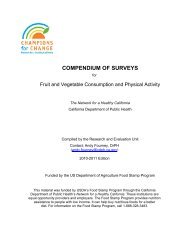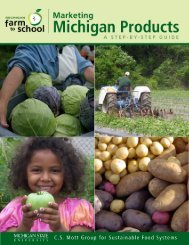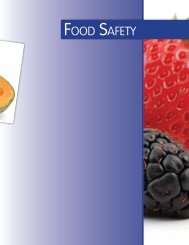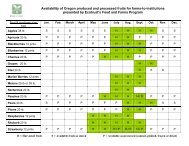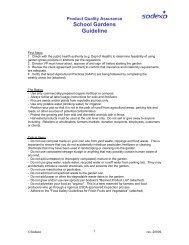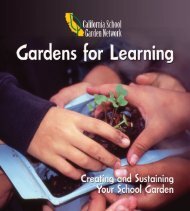eval report cover.indd - New Jersey Farm to School Network Wiki
eval report cover.indd - New Jersey Farm to School Network Wiki
eval report cover.indd - New Jersey Farm to School Network Wiki
You also want an ePaper? Increase the reach of your titles
YUMPU automatically turns print PDFs into web optimized ePapers that Google loves.
CSA-CA: CSA IN THE CLASSROOM PROGRAM –LOS ANGELES UNIFIED SCHOOL DISTRICT, CALIFORNIAConclusions <strong>Farm</strong> <strong>to</strong> <strong>School</strong> and RecommendationsProgram ProfilesDuring the 2002-03 school year, students inmore than 990 classrooms in 41 different LosAngeles Unified <strong>School</strong> District schools hadthe opportunity <strong>to</strong> taste and learn about farm freshproduce grown in Southern California. These activitieswere part of CSA-CA: an educational programseeking <strong>to</strong> integrate health and nutrition, agricultureand the environment. Project partners included theCenter for Food & Justice (CFJ), Occidental College,Tierra Miguel Foundation CSA <strong>Farm</strong>, and theLos Angeles Unified <strong>School</strong> District <strong>Network</strong> for aHealthy California – previously LAUSD Nutrition<strong>Network</strong> (LAUSD NN).CFJ acted as a liaison between the farm and theLAUSD NN’s nutrition education program. CFJcoordinated product delivery schedules and communicatedwith participating schools and teachers<strong>to</strong> facilitate the purchasing and payment process.Los Angeles Unified<strong>School</strong> District, CAFree / reduced mealeligibility: 77.2%Total schools: 768Enrollment: 722,319Demographics:73.2% Hispanic, 11.4% AfricanAmerican, 8.8% WhiteLocal product used in:In-class nutrition educationand taste testsOther program components:<strong>Farm</strong> trips, <strong>Farm</strong>er in theClassroom, <strong>Farm</strong>ers’ marketstands on school sitesCFJ paid the farm in advance for produce deliveries which were ultimately funded by theNutrition <strong>Network</strong>. CFJ also <strong>eval</strong>uated the program.LAUSD NN developed promotional materials <strong>to</strong> market the project <strong>to</strong> teachers. Th e projectwas promoted along with existing farm <strong>to</strong> school programming coordinated by theLAUSD NN which included farmer visits <strong>to</strong> classrooms and farmers’ market stands set upfor schools. A newsletter for teachers was developed and inserted in the produce box. Thenewsletter included information about the farm, nutritional information about the producein the box, and related nutrition education messages.Th e CSA in the Classroom program established a direct connection between the LAUSDclassrooms and Tierra Miguel, a community supported agriculture farm based in the SanDiego area. Tierra Miguel delivered weekly boxes of organic fruits and vegetables <strong>to</strong> classroomsat the participating low-income LAUSD Nutrition <strong>Network</strong> schools. The producewas used for nutrition education and taste testing.Teacher feedback on the program was encouraging. Over 90% of teachers were “VeryHappy” with the quality, variety and overall aspects of the produce and usefulness for nutritioneducation. A wide variety of <strong>to</strong>pics was <strong>cover</strong>ed in classroom discussion ranging fromagriculture, farming, nutrition and the environment and incorporated in<strong>to</strong> subject areassuch as literature, arts, math and geography. Teachers responded overwhelmingly positivelyregarding the educational value of the program.A major challenge <strong>to</strong> the widespread replication of the project was the need for the participatingfarm <strong>to</strong> be paid in advance of planting, which is the business model of a CSA farm.Th is was not feasible through the existing LAUSD NN purchasing system, and hence CFJoffered <strong>to</strong> front the payments <strong>to</strong> the farm for the pilot project. This posed a problem withthe long-term viability of the program. The CSA-CA program was discontinued after twoyears of CFJ involvement.Margaret Haase et al, Center for Food & Justice, Fresh from the <strong>Farm</strong> and In<strong>to</strong> the Classroom, 2004.68 Bearing Fruit: <strong>Farm</strong> <strong>to</strong> <strong>School</strong> Evaluation Resources and Recommendations



